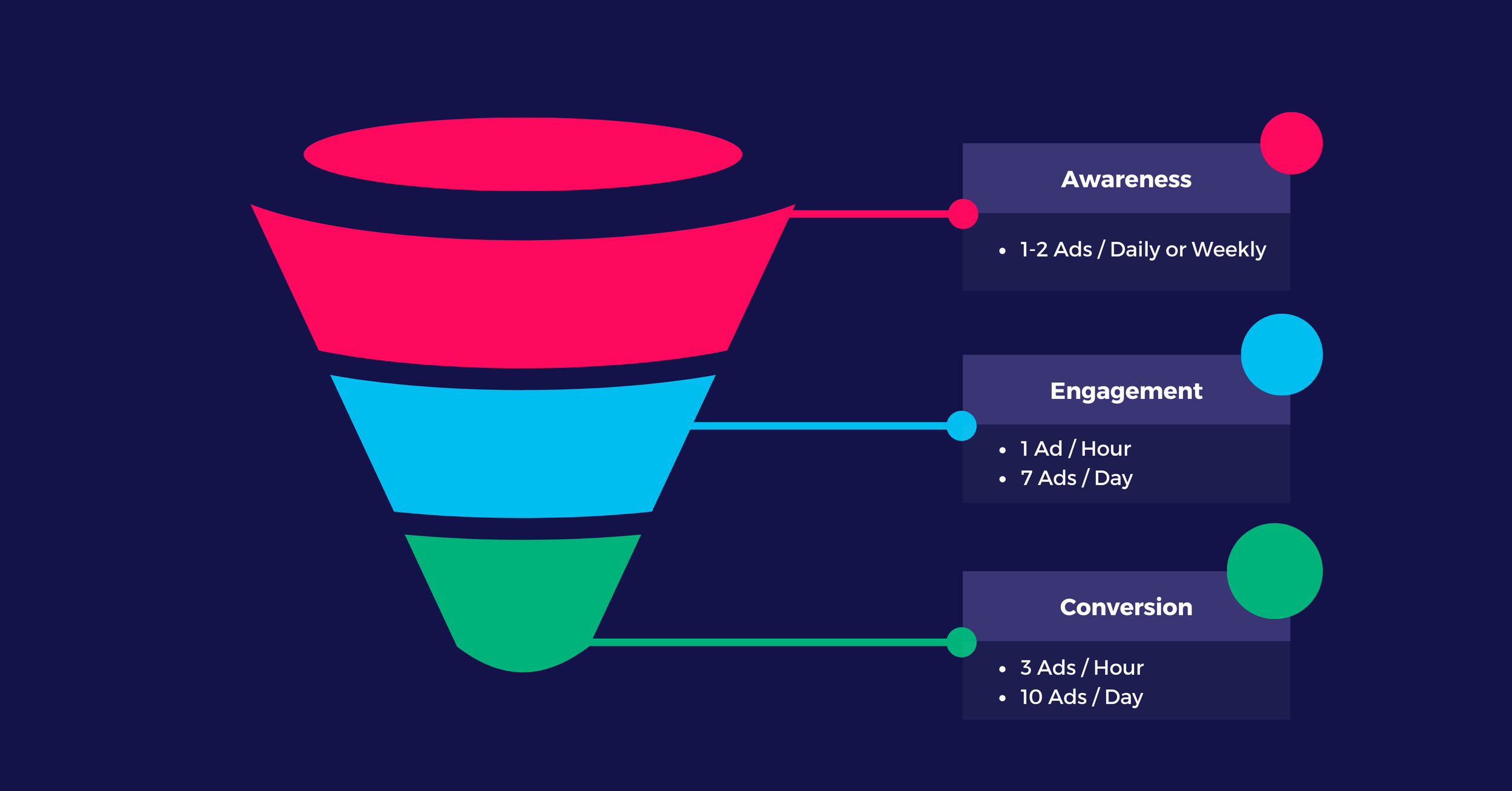What Is Frequency in Marketing & Why Is It Important?
| Pathlabs Marketing |
| February 16th, 2024 |
This blog discusses the concept of frequency and how it applies to Pathlabs’ wheelhouse of media execution for paid digital media campaigns.
What Is Frequency in Marketing?
In digital marketing and advertising, frequency refers to the number of times (or the rate at which) an ad for a campaign serves unique users within a specified timeframe.
For instance, if a CTV or display ad campaign has a high daily frequency, this simply implies that targeted users are being served numerous ad impressions within 24 hours.
When Do Teams Consider Frequency When Executing a Digital Media Campaign?
Advertising and media teams consider frequency throughout the lifecycle of executing a digital media campaign.
Pre-Campaign
While building their campaigns in ad platforms – such as Google Ads, The Trade Desk, and Meta Ads – teams set frequency parameters.
These include a minimum frequency goal and maximum ceiling – called a frequency cap – which control ad-serving frequency when the campaign launches.
Below is the frequency rail section in The Trade Desk platform.
Mid-Campaign
Upon launching the campaign, teams track performance as the platform bids on and serves ads to target users, optimizing toward the set minimum frequency goal and cap.
It is common practice for teams to modify their frequency parameters mid-flight, such as lowering or raising the frequency to meet pacing goals.
Post-Campaign
Once a campaign concludes, teams don’t forget about frequency. They conduct a post-campaign-flight analysis, assessing final performance against frequency metrics to draw lines between ad-serving frequency, user action, and brand lift.
Why Is Marketing Frequency Important?
Frequency is important as it is an integral consideration for every digital media campaign a team executes.
Additionally, it is imperative to calibrate a campaign’s frequency parameters properly to ensure timely ad-serving that engages users and organically drives them down the funnel.
To better understand this importance, let’s look at two campaigns, campaign A and campaign B.
Campaign A aims to build awareness among a broad audience
Campaign B focuses on retargeting a first-party data list to drive conversions
When building the campaigns, Campaign A would need frequency parameters that guarantee solid ad exposure without becoming intrusive, while Campaign B would need an assertive frequency that delivers multiple impressions to the target list.
If the two campaigns switched frequency parameters, it would immediately lead to inefficiencies:
Campaign A would annoy its broad audience with excessive impressions
Campaign B wouldn’t reach its narrow audience enough to motivate action within the desired timeframe
“The key takeaway here, as we see with these two campaigns, is that there is a specific manner in which teams must approach and set their frequency to spur the best performance – there is no one-size-fits-all frequency strategy.
Moreover, teams that figure out how to set the right minimum frequency goals and caps and know when to modify frequency at a moment’s notice to capitalize on critical opportunities will always have a competitive advantage and be most powerful at media execution.”
MEPs and Digital Media Campaign Frequency
In reality, it takes lots of experience to be apt to make nuanced calls regarding the frequency of a campaign. For agencies executing numerous campaigns for clients, the sheer volume and complexity around frequency decisions can be overwhelming.
Fortunately, agencies now have the option to work with a media execution partner. MEPs provide workflows, technology, and, most importantly, trained experts to agencies, stepping in to handle their media execution.
MEP experts are always prepared and, honestly, excited to suggest strategies around frequency, taking the weight off the shoulders of the agency’s team.
The Science Behind Repeated Exposure
Another reason frequency is an important consideration for digital media campaigns is repetition; teams must strive towards repetitively placing their message in front of the same audience.
These assertions stem from concepts like the ‘Rule of Seven’ and the mere exposure effect, which theorize that repeated exposure to certain stimuli or touchpoints, in our case, digital ads, will lead to better recall and even a preference towards the stimuli.
This overall rings true in a marketing context, as sufficient ad-serving frequency will make users remember and develop an interest in the brand. Teams can’t just expect to serve an ad once and instantly drive performance.
“One of the biggest mistakes advertisers make is hitting too many people too few times. A benefit digital advertisers and marketers have nowadays with ad platforms is more accessible avenues to target and serve impressions to online locations and users, helping meet this goal of repeated exposure.
A challenge that will continue to persist, though, is that with ongoing cookie deprecation and limits to tracking, we have less of an ability to guarantee serving ads to every user at a given frequency. This may put this metric in question.”
Finding the Balance Between Being Memorable & Avoiding Ad Fatigue
Teams will hear concepts like the ‘Rule of Seven’ and the mere exposure effect and automatically think they need to boost the frequency of their campaigns. This is not always the case.
In fact, over-serving ads can cause ad fatigue in an audience, making them either disengage when they see the same ad(s) or, worse, begin to perceive the brand negatively.
Although teams must find their own special formula that balances effective repetitive ad-serving and ineffective overserving, the following considerations are a good starting point.
Implement a high ad frequency when:
The campaign is for a new brand or to promote a new message
The brand has a low market share
The purchase cycle or campaign has a short duration
The message is either highly complex or not unique
Consider a low ad frequency when:
The campaign is for an established brand or message
The brand has a high market share
The purchase cycle or campaign has a long duration
The message is either not complex or highly unique
Frequency Cap Considerations:
How to Calculate Frequency for an Ad Campaign?
There is no single way to calculate frequency; teams normally rely on the ad platform used for campaign execution or an additional tool to calculate and report it.
One popular calculation is taking the number of impressions served during a given time frame and dividing it by the unique user reach, putting it in the perspective of average impression frequency per user.
Meanwhile, other platforms have adopted algorithm and machine-learning-based approaches, relying on models that consider different metrics, factors, and user behaviors, calculating a custom frequency.
How to Improve Frequency in Marketing
Understand the Frequency and Reach Constraint
A familiar crux in advertising is to decide between prioritizing frequency or reach.
Teams can generally target and reach a large audience of unique users, but serving these users ads at a high frequency is costly. Meanwhile, they can target a narrow audience at high frequency but may not reach as many users as they want.
Once again, there is no clear solution, but teams should generally expect to keep a broad audience reach at a low frequency towards the top of the funnel as they explore their audience and spur awareness. While the audience becomes more known and narrow, teams can increase frequency per user.
Implement Frequency Cap
Teams should always leverage a frequency cap, which helps in many ways.
Teams might test a single ad creative and see at what frequency they can serve it until users stop engaging. Then, use a frequency cap to ensure future campaign frequency caps never surpass this limit.
Furthermore, they may rely on a frequency cap to ensure the ad budget doesn’t spend too fast. For example, if there is no frequency cap, the ad platform could target the same users with excess impressions over a short time, investing too much spend per user.
Remember that if a day and hour-based cap are available, use both. These allow more specification and efficient frequency-cap layering.
To illustrate, if a team only uses a daily frequency of five ads every 24 hours, some platforms may serve users all their allotted ads within the first hour, leaving 23 hours in the day until ads can serve again. Using only an hourly cap can be better, like serving an ad every six hours, but this still has drawbacks.
Leveraging both frequency caps will permit flexibility: teams could run a daily cap of five ads and set the hourly cap of two ads every six hours. In this case, the ads serve at a more spread-out frequency during the day. This will likely promote more isolated and salient opportunities for user engagement.
Content Variation
Many platforms used for media execution and ad-serving allow teams to provide several versions of campaign creative. If possible, teams should leverage this benefit.
This can help delay ad fatigue, as although users are seeing ads from the same brand multiple times, the different creatives at least provide variety.
Content variation in creative can be simply having different copy versions or changing the entire color scheme or media across versions.
The Effects of Frequency on Customer Retention
The sales funnel doesn't end after conversion; teams should remember they can still run campaigns to reengage users who have already converted.
Teams most commonly do so through drip campaigns, serving ads consistently over time, at low frequency. A drip campaign may serve anywhere from one to two ads a day to new or past customers – just enough to keep the brand somewhat fresh in their minds.
This is a popular approach in digital advertising and other marketing fields like email campaigning.
In Conclusion…
Frequency in digital marketing and advertising fundamentally pertains to the rate at which advertisements and content serve to users over a specified period.
Advertisers prioritize frequency management during digital media campaigns, tailoring it to enhance user engagement. To effectively leverage frequency in a campaign, teams must conduct thorough research to understand frequency caps, frequency minimums, and the appropriate times to adjust frequency to boost performance.
Although pinpointing the perfect frequency for a campaign may remain elusive, in-house teams for brands can consistently find support and guidance through agencies, while these agencies can seek support from MEPs.














